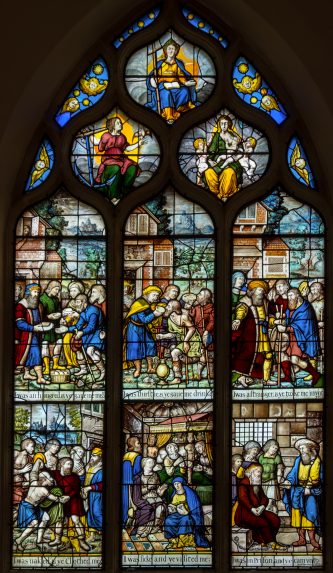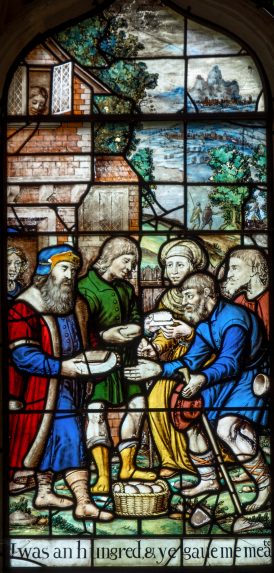Church of All Saints, Messing, Essex
Address
Church of All Saints, Messing, Essex, CO5 9TRRecommended by
Highlight
East window of chancelArtist, maker and date
Attributed to Abraham van Linge, c.1634Reason for highlighting
The main lights of the window depict the Works of Mercy. The works are undertaken by six richly dressed benefactors who in four of the six scenes stand at the door of a house set in a landscape background. The tracery contains female personifications of Faith, Hope and Charity surrounded by winged putto heads and stars. The glass-painting is of a high quality and the colours are rich, with pot metal glass, enamel paints and yellow stain being used.
This is a fine example of the early-seventeenth century revival of religious glass-painting promoted by Archbishop Laud. Its subject matter and imagery are impeccably Protestant, with emphasis on good works, absence of religious figures and the English text at the foot of each of the six scenes copied from the King James Bible. However, it is visibly the direct descendant of late medieval windows depicting the Works of Mercy, such as the early fifteenth century example at All Saints, North St, York and two panels depicting Feeding the Hungry and Clothing the Naked from another of c.1482 at the Collegiate Church of Holy Trinity, Tattershall, Lincolnshire.
The window is almost complete and in reasonably good condition. It was conserved by Leonie Seliger in 1999.
Artist/maker notes
Like many early 17th-century windows, this one has been attributed to Abraham Van Linge on stylistic grounds in the absence of documentary evidence. The putto heads are from the same cartoon as one surviving from the London glazier Richard Butler’s fragmentary glazing of 1637 in Winchester Cathedral. In 1623 Van Linge and Butler had collaborated in glazing Lincoln’s Inn Chapel, London.
Abraham van Linge (flourished 1623-42) probably followed his older brother Bernard (1598-c.1644) to England in 1623. Both were from Emden, East Frisia, where both their father and grandfather were masters of the Emden glaziers’ guild. His work is better represented than that of his brother, although less well documented. As a result there are debates over the precise attribution of works between the brothers, whose work is particularly prominent in a number of Oxford Colleges.
Source: Bernard van Linge by Alexander Faludy – Oxford Dictionary of National Biography



Other comments
The chancel was rebuilt and furnished with panelling and communion stalls by Hanameel Chibborne who held the manor and advowson of Messing. He commissioned the large ornate wooden panel dated 1634 which depicts on one side the royal arms of Charles I above biblical texts stressing obedience to God and King, and on the other side the emblems of the Prince of Wales above the arms of Chibborne and his wife. The fittings and glazing at Messing exemplify the brand of Anglicanism that Charles I wanted his subjects to embrace but was snuffed out by the Civil War.
Sources:
R. Carter, Simply Messing: A Partial Account, 1996, pp.15-19.
P. Hebgin-Barnes & C. Parkinson, The Medieval Stained Glass of Essex (forthcoming)